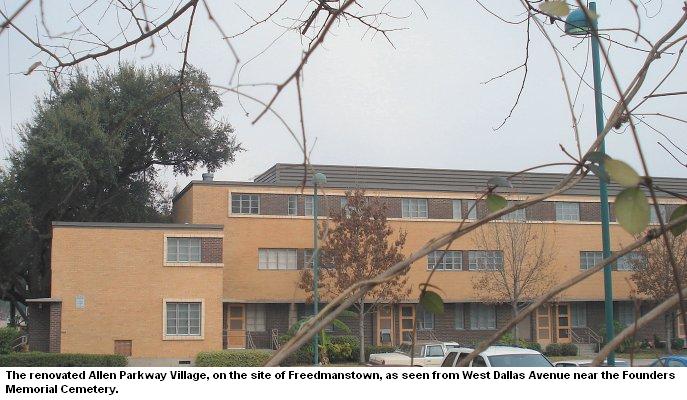Help came from sympathetic businessmen and influential citizens of Houston. In particular, Garrett S. Hardcastle set aside a tract of land that he owned as a residential development for these newly free persons. The Hardcastle Subdivision soon became known as Freedmanstown.
Hardcastle came to Houston in 1836 from the eastern shore of Maryland. He was a devoted Methodist and when the Shearn Methodist Church was organized in 1841, he was made a steward of the church, a position he held until his death in 1884. From the mid-1850's, Hardcastle began to acquire land along the north side of the San Felipe Road (present day West Dallas Avenue). On July 14, 1855, he purchased land from William R. Baker that lay between his own land on the west and the land of Clement R. Hobson on the east. Hardcastle acquired the twenty acres that Hobson owned on May 6, 1857, and he moved into Hobson's former home on the property.
As the Assessor and Collector of taxes for Harris County, Garrett Hardcastle and other Methodists paid the taxes for freed slaves and helped them keep their properties. By 1866, twenty-two dwellings in the subdivision were occupied by freed slaves. In time, besides Freedmanstown, four adjoining additions in western part of the 4th Ward became largely black-owned residential neighborhoods: W. R. Baker Addition, the Castanie Addition, the Senechal Addition and the Hopson Addition. The highest percent black ownership was in Freedmanstown.
In 1874, the local newspaper reflected a somewhat less than generous view of the residents of Freedmanstown. It noted that the area had to be patrolled by the police in order to preserve order and curb the vandalism. The neighborhood was second only to Vinegar Hill in notoriety, and the children ran naked while the place reeked of "idleness and crime." Nevertheless, residents such as Richard Allen, the first African-American state legislator from Houston, pursued the ideals of good schools and voting rights for blacks in spite of the rising specter of "Jim Crow" laws that would come into place by the end of the 19th century.
Although the black community in the adjacent subdivisions seemed to thrive and prosper, the Hardcastle Subdivision/Freedmanstown declined. In 1908, City officials created the fifteen block "Reservation" in the Freedmanstown district in an attempt to plan and reserve a geographic district for all of the prostitutes of the City. The Reservation was formally abolished as an entity of the City in 1915.
 Freemanstown
continued to lose its identity in the pre-World War II period. As one
of the nation's first urban renewal projects, the San Felipe Courts
(later Allen Parkway Village) were constructed in 1939-1940 on the
Hardcastle Subdivision, Freedmanstown and part of the New City Cemetery
of 1879 as housing for white working class
families.
Freemanstown
continued to lose its identity in the pre-World War II period. As one
of the nation's first urban renewal projects, the San Felipe Courts
(later Allen Parkway Village) were constructed in 1939-1940 on the
Hardcastle Subdivision, Freedmanstown and part of the New City Cemetery
of 1879 as housing for white working class
families. The final indignity for the original Freedmanstown came in 1984 when the National Register of Historic Places designation of the Freedmen's Town Historic District in the 4th Ward went to the black community that was south of West Dallas Avenue and between Genesee Street, West Gray Street and Arthur Street.